|
STEP ONE: recognizing the early signs of a sickness Everyday, when you feed your bettas you should examine them. Overtime your eyes will become trained and you will be able to immediately detect the slightest chance in your bettas appearance or body language. How can you tell if your betta is "under the weather"? Just compare the two columns in the chart below:
|
| HEALTHY BETTA |
SICK BETTA |
| Eats like a little pig | Does not eat at all or eats reluctantly and may spit out his food. |
| Swims around and is active | Is not active. May lay at the bottom and come up only for air, or may stay at the surface in a corner. |
| Acts normal | Darts and purposely runs into anything he can (gravel, rocks, etc) in an effort to scratch itself. |
| Is colorful and vibrant | Looks paler, color is dull, may turn gray |
| Fins and tail are spread out like fans | Tail and sometimes fins are clumped, closed, stiff looking or falling apart |
| Body looks slick and clean | Body may have: open sores, white cottony patches, red spots, lumps or white spots. |
| Eyes are normal | One or both eyes are protruding and swollen |
| Gills are normal | One or both gills do not close all the way and stay half open (swollen/inflamed). They may look red. |
| Scales are smooth | Scales are raised (like a pine cone) |
| Belly looks normal | Belly looks too hollow or on the contrary is abnormally swollen and big. |
| STEP TWO: Isolating the unhealthy betta
If your betta exhibits one or more of the above right column symptoms then it is sick. It must immediately be removed from any community or shared tank and isolated in a half gallon jar. Use the same tank water to avoid an abrupt change of water condition when jarring the sick betta. If betta was already in a jar, then do a full water change to provide a clean environment for treatment. I recommend putting him in a new, sanitized jar. Jar should be kept in a warm room. Be sure to wash your hands with a good antibacterial soap after handling your sick fish to not spread disease to your healthy ones. Anything that comes in contact with the sick fish (fish net, fingers, spoon, jar, etc) will have to be disinfected prior to being used for other fish.
|
| STEP THREE: Diagnosis and treatment
Next you must try to make an accurate diagnosis of your betta‘s disease. Once you know what disease you are dealing with, then you can pick the best course of treatment for it. Below, I have listed the main betta diseases, their individual symptoms, and listed the medications I have used in the past to try to fight each disease off. Please go down the list and see which symptoms/disease seem to qualify. Please note that I do not guaranty that the treatment I recommend will work and cannot predict what effect it will have on your specific betta. Therefore you use this chart and info AT YOUR OWN RISK. |
| DISEASE: FUNGAL
INFECTION
GENERAL INFO: If you always add aquarium salt to your betta’s water (1 teaspoon of aquarium salt per 2 1/2 Gal of water) and one drop of Aquarisol per gal, your betta will probably never get fungus. It is contagious, but bettas will more than likely recover if treated promptly. |
| SYMPTOMS: Betta has white cottony like patches on its body or head. He may be less active, may have stopped eating, fins may be clumped, color may be pale. |
| TREATMENT: Do a full jar water change. Add “Fungus Eliminator” by Jungle. These are crystals are dosage should be about 30-40 grains per 1/2 gal. Water should have a nice gold color, not too dark. Do not overmedicate! Change water every third day and add a new dose of same medication. Continue until all fungus has disappeared. Then keep betta jarred for another 2 weeks at least and instead of Fungus Eliminator, just add 1 drop of maroxy or of Methylene Blue in your betta’s water to clean any other bacteria/fungus that may still be present. Adding salt to the water would also help healing. |
| DISEASE: TAIL ROT OR
FIN ROT (OR BOTH!)
GENERAL INFO: This disease comes mainly from dirty water. If you keep his water VERY clean Mr. Betta will never get tail/fin rot. It is not overly contagious, and bettas will more than likely recover if treated promptly. Fins/tail will grow back, though may not have same color or may not look as good or be as long.
frayed fins and a darker edge are clear signs of fin rot |
| SYMPTOMS: Betta’s fins and/or tail seem to be getting shorter and shorter. Or they seem to be falling apart and dissolving. There may be a darker color (or a reddish one) to the edge of the betta’s fins/tail. He may be still active and eating normally, or may have stopped eating, fins may be clumped, color may be pale. |
| TREATMENT:
Do a full jar water change.
Add “Neosulfex” by Aquatronics. This medication comes in capsules. A
full capsule treats 10 gal of water. So for a 1/2 gallon of water,
open the capsule and take the right proportion of powder and
sprinkle on jar water. You may steer gently with a disposable
plastic spoon. This is a white powder and will not affect the color
of the water. Do not overmedicate! Change water every third day and
add a new dose of same medication. Continue until fins/tail stop
receding and start showing some new growth. It may take up to 4
weeks to work, so don’t give up. In case of stubborn rot, you can
use Neosulfex TOGETHER with "fungus eliminator" (crystal form) by
'Jungle'. This is my own brew and it has healed many a rot :). Once
rot stops and fins start growing back you can switch to Bettamax and
keep betta in Bettamax for a month or so, just to be sure. Bettamax
will not hurt your fish and also has vitamins etc that help the
healing process.
A small pinch of Aquarium salt will also help the healing process. |
| DISEASE: ADVANCED FIN
AND BODY ROT
GENERAL INFO: This disease starts as a regular fin rot, but the rot progresses quite rapidly and is harder to stop. Soon no fins are left as all tissues have been eaten away. Then the rot proceeds to attack the body. Not a pretty picture.
close up of a tail and fins that are being eaten away by the advanced rot, you can see the top dorsal is almost all gone and the bacteria is getting ready to attack the body now. |
| SYMPTOMS: Fins and or tail start rotting away, usually starting from the edge, but sometimes it starts at the base of the fin (especially dorsal) and attacks the body directly. Diseases progresses rapidly and as the tissues are being eaten away, you might see the fins bones stick out (yuk). Once fins have been consumed, rot will proceed onto the body. At this stage the disease is hard to reverse although the betta might continue to live for months if treated properly. If not treated, it will die promtly (and probably suffers quite a bit :(( ). |
| TREATMENT:
Do a full jar water change.
Preferably provide a new jar. You must combine several medications
to have a chance to stop this thing. Use "Ampicillex” by Aquatronics
and double the dose if needed, and use at the same time
tetracycline. These medications comes in capsules. A full capsule
treats 10 gal of water. So for a 1/2 gallon of water, open the
capsule and take the right proportion of powder and sprinkle on jar
water. You may steer gently with a disposable plastic spoon.
Tetracycline might turn the color of the water to a dark yellow or
red. Overmedicate a little might help! Change water every third day
and add a new dose of same medication. Continue until fins/tail stop
receding and start showing some new growth. It may take up to 4
weeks to work, so don’t give up. Once healing starts you can ease up
on the heavy medication and switch to bettamax, which will prevent
the bacteria from multiplying again. Change jar and sanitize
old jar every week until healed.
A small pinch of Aquarium salt will also help the healing process. |
| DISEASE:
ICK
GENERAL INFO: Ick is a pesky little parasite. If you always add aquarium salt to your betta’s water (1 teaspoon of aquarium salt per 2 1/2 Gal of water) and one drop of Aquarisol per gal, your betta will never get ick. It is very contagious, but bettas will fully recover if treated promptly. Frozen live food may carry ich. |
| SYMPTOMS: Betta has white dots (looks like he was sprinkled with salt) all over his body and head, even eyes. He may be less active, may have stopped eating, fins may be clumped. |
| TREATMENT: Ick is a parasite. Because ick is contagious, it is preferable to treat the whole tank when one fish is found to have it. Ick is temperature sensitive: Leave your betta in the community tank and raise temperature to 85 F and add one drop of Aquarisol per gal every day until cured. It will only take a few days to get rid of the pesky little parasites. If your betta lives in a jar/bowl, then you cannot raise the temperature. Do not attempt to put a heater in a tank smaller than 5 gal. You cannot control temperature fluctuation in a small tank/bowl and will probably end up boiling your betta!!! Do a full water change and add one drop of Aquarisol and salt (per above proportions) to the water. If you have empty tank and heater, then move betta to it and raise temperature of water to 85 F as per above. The reason is that the parasites are sensitive to the heat and at 85F they become free swimming (detach themselves from betta’s skin and go for a swim in the water which contains the Aquarisol. Aquarisol then kills them). Guess their mothers never told them to never go for a swim right after dinner!! :)))) |
| DISEASE:
VELVET
GENERAL INFO: Velvet is another pesky little parasite. If you always add aquarium salt to your betta’s water (1 teaspoon of aquarium salt per 2 1/2 Gal of water) and one drop of Aquarisol per gal, your betta will probably never get velvet. It is very contagious, but bettas will fully recover if treated promptly. Velvet is the number one killer of small betta fries. :(( |
| SYMPTOMS: Velvet is hard to spot, but can be best spotted with a flashlight. Shine the light on the betta’s body: if it looks like it is covered with a fine gold or rust mist, then it has velvet. A betta with velvet will act sick, so look for clamped fins, scratching against rocks/gravel/tank, loss of appetite, loss of color etc... |
| TREATMENT: Velvet is a parasite. Because velvet is very VERY contagious, it is preferable to treat the whole tank when one fish is found to have it. Follow same procedure as for “ich” (see above). Aquarisol works good. Also, Maracide has done a good job for me in the past. Isolate any individual with velvet, treat the whole tank even if other fish look OK and remember WASH YOUR HANDS!!! |
| DISEASE:
POPEYE
GENERAL INFO: If you always keep your betta’s water very clean, he will probably never get Popeye. Popeye is a bacterial infection caused by poor water condition (in other words filthy water because you were too darn lazy to get off the couch and attend to your betta!!!). On occasion, it happens to conscientious breeders, too :)).. |
| SYMPTOMS: One or both of Mr. Betta’s eyes start bulging out. In about 2 to 7 days the eye might look so grotesque you will be afraid to look at your betta. Casimodo on a bad day will look more attractive then your betta at that point!! Please do not destroy your betta! Bettas often have full recovery from it and look normal again, as if nothing had happened. During outbreak, betta may be less active, may stop eating. |
| TREATMENT: popeye is not fatal and often betta will fully recover. On occasion he may lose an eye. But if you catch it right away, he should be fine. Immediately do a full water change. Keep his water very clean, changing it every third day. After putting him in clean water, add the antibiotic Ampicilex (Aquatronics) to his water. This medication comes in capsules. A full capsule treats 10 gal of water. So for a 1/2 gallon of water, open the capsule and take the right proportion of powder and sprinkle on jar water. You may steer gently with a disposable plastic spoon. This is a white powder and will not affect the color of the water. Do not overmedicate! Once Betta’s eyes are back to normal, stop the medication. And keep his water clean from now on darn it!! |
| DISEASE:
DROPSY
GENERAL INFO: This is a most common and most fatal betta disease. Very little is know about it, other than it is abdominal bloating and that the tissues of betta get filled with fluids. Some say it is contagious, other say it is not. All I know is that it has killed many bettas in my fishroom over the years and I have never EVER been able to save a single one of them. I treat it as a very contagious disease, since it is most fatal, and I don’t joke around with it. |
| SYMPTOMS: It is easy to diagnose a betta with Dropsy: Look for two signs: an abnormally big (bloated) belly and if you look at betta from the top, raised scales. Scales will look like an open pine cone. If you see this, you are out of luck, and so is Betta. He will soon go to betta heaven :((… |
| TREATMENT: No known cure. Keep water clean, keep him AWAY from any other bettas etc… You may try tetracycline if you catch it very early on. I always try something, just in case, though I have to yet found anything that will stop this horrible disease. It may take up to 15 days for betta to die, though usually about 5 days. Any betta with dropsy should be immediately ISOLATED!!!! Prayer may not hurt. |
| DISEASE: SWIM BLADDER
DISORDER
GENERAL INFO: This is also a common betta problem. It is not contagious. It comes from overfeeding. It is especially common in very young bettas (30 to 60 days old). |
| SYMPTOMS: Bettas with a swim bladder disorder will have difficulty swimming, because their swim bladder (located alongside the spine between the belly and the tail) is either too short (causing them to not be able to swim horizontally) or it is swollen (causing them to float on one side). Double Tail bettas, because they have a shorter body, are especially prone to the “floaters” problem. In the case of a short swim bladder, the bettas will not be able to maneuver and swimming becomes so difficult, they prefer to just lay at the bottom, sliding on their bellies, which is why they are called “belly sliders”. And they do look like a pathetic bunch, at that point. :) |
| TREATMENT: Bettas may recover on their own, but since overfeeding induces swimbladder disorders in most cases, the first thing to do is feed a lot less. Brine shrimp and too much of it is the biggest culprit, so if your bettas are bellysliding, stop the brine shrimp for a while and thereafter learn to have a more balanced diet, alternating brine shrimp with microworms or worms (depending on how old your bettas are). Do not kill a betta with a swimbladder disorder. It may recover on its own at any time, and is not suffering. Further more, the ailment is NOT contagious. |
| DISEASE: EXTERNAL
PARASITES
GENERAL INFO: If you do not add some aquarium salt (1 teaspoon per 5 gal) to your betta’s water, your betta is likely to get some parasites. Especially if you feed him live food, or worse yet, frozen live food, such as frozen brine shrimp. These frozen food carry a lot of parasite eggs I guess, because the correlation between frozen live food and the onset of a parasite epidemic has been well established both by me and other breeder friends of mine. |
| SYMPTOMS: It is easy to diagnose a betta with external parasites: It will dart and scratch itself against anything it can find, such as gravel, rocks, heaters, tank walls, etc… You will probably never be able to actually see the parasites themselves. Look instead for a behavioral change in your betta. If it looks like it is on speed or acid, then it has parasites!! :)))) |
| TREATMENT: Do a full water change for jars or a 70% water change for tanks. (To get rid of some of the parasites and their eggs, etc..). Easy and efficient, immediately add AQUARIUM salt (1 tablespoon per 5 gallons) (and NOT table salt, duh!!) and add one drop of aquarisol per gal. I personally recommend always adding the above to your water to prevent any parasites. I NEVER have ANY, because I religiously add both salt and aquarisol to my water. If the epidemic is advanced, you might want to go for something a little stronger, like “Clout”. Clout will color your rocks and the silicon of your glass tank blue :(. A small price to pay to save your bettas, though… Follow manufacturer’s directions. |
| DISEASE: INTERNAL
PARASITES
GENERAL INFO: If you feed live brown worms, you can easily give your bettas some internal parasites. Those are a real pest because you can’t see them, the bettas behavior does not change, except they start looking skinny and dying on you. It is therefore hard to diagnose. |
| SYMPTOMS: Bettas start dying for no apparent reason. They may or may not look skinnier. |
| TREATMENT: Do a full water change for jars or a 70% water change for tanks. (To get rid of some of the parasites and their eggs, etc..). Add Clout to the water until bettas recover. Follow manufacturer’s instructions. Clout may be hard to find at some pet stores, but a good fish store would carry it or be able to get it for you. |
| DISEASE: BACTERIAL
INFECTION
GENERAL INFO: If the betta‘s water becomes fouled with uneaten food and fish waste, if it is not well filtered or if the jars are not kept sparkling clean, then bacterial bloom will occur. Bettas with a deficient immune system (when a betta is stressed, because it was scared, or moved or shipped, etc… its immune system will become deficient) will catch whatever is lurking in the water, including the bacterias. They will have a “bacterial infection”. VERY CONTAGIOUS!! |
| SYMPTOMS: Betta may have clamped fins, lay at bottom or at surface, not eat, lose its color, turn gray, barely swim around. In more advanced cases, its body may start developing red patches, open sores and all kinds of nasty looking stuff. (Even holes in its head!! YIKES!!) |
| TREATMENT:
Do a full water change for
jars or a 70% water change for tanks. (To get rid of some of the
bacteria present). Clean filter, change filtering system, remove any
uneaten food rotting, or any dead fish!!! Salt kills bacteria, so
there again, adding salt would be beneficial: Add AQUARIUM salt (1
tablespoon per 5 gallons) (and NOT table salt, duh!!) immediately.
Isolate any bettas with symptoms if in a community tank.
You should also treat the whole tank. There is a wide variety of antibiotics available for fish. REMEMBER: if the carbon in your filter is less then a week old, remote it!! The carbon would otherwise absorb all the medication and you would be flushing your money down the tube. Oh, and did I mention money?? Yes, brace yourself, cause your little fishies are gonna cost you a bundle, medication can get pretty darn expensive!! If the sick bettas are small fries, I truly recommend using Tetracyclin. It has never let me down before. If older, you might try Tetracyclin, or Marcacyn I and II combined, or whatever you find at your store. Go for “broad spectrum” antibiotics, though. Follow manufacturer’s instructions and don’t stop the treatment until your bettas are well again. If betta is jarred, then as usual, figure out how much water your jar contains and divide the quantity of medication accordingly. Capsules are easier then tablets, because one can open a capsule and just sprinkle a tiny itsy bit of powder in jar. Tables, you will have to first crush, then divide. Well, have a blast!!! Oh, and did I mention that both Methylen Blue or Maroxy are very efficient bacteria killers? They seem to prevent the blooming of bacteria and often, if the infection is mild, a simple srop of either of these two products will cure betta. Further more they are INEXPENSIVE (yop, I figured you would like that part!! :)) ) |
| DISEASE: UNKNOWN –
POSSIBLE DEPRESSION
GENERAL INFO: Sometimes a betta will act sick but not exhibits any symptoms. He could either have internal parasites, or some mild bacterial infection, or simply be depressed. Bettas often become depressed when they are first jarred as young fries, and get separated from their siblings. Also, males often become depressed after spawning. A depressed betta will stop eating and swimming around and may let himself starve to death. This is not as unusual as one may think! |
| SYMPTOMS: Bettas may or may not have clamped fins, lay at bottom or at surface, not eat, barely swim around. They will not flare or build bubble nests. |
| TREATMENT: Do a full water change for jars or a 70% water change for tanks. Isolate any suspected sick betta. Add one drop of marOxy or methylene Blue to each gal of water. You may add one drop per 1/2 gal jars and even one drop per 1/4 jars. I have done it a million time and have never lost one betta that way. If the betta was just spawned or just jarred, and it is likely to simply have depression: in the case of a newly jarred young betta, float his jar inside the tank where his siblins still are. This should help him cope with the isolation. In the case of a male who has just been spawned, try floating him inside a tank containing lots of other bettas, females preferably. It has always worked for me. When floating a jar in a larger tank, be careful: if you have a power filter or canister filter the water flow created will slowly but surely pull in the floating jar and once the jar is under the water flow, it will fill up with water and sink, releasing the betta into the tank!! Therefore, make sure the jar is secured somehow and cannot drift. |
| DISEASE: INFLAMED
GILLS
GENERAL INFO: The gill or gills of a betta may become inflamed, because of nitrate poisoning, and possibly bacterial infections, or even a defective gill (if it was born that way). |
| SYMPTOMS: One or both gills will not close all the way (look at betta from the top it is easier to see it then), gills may look red (inflamed) or not, in the last stages, the betta may be gasping for air, unable to breath. |
| TREATMENT: Isolate sick betta. Do a full jar water change every third day. Every time you change water, add antibiotic (Pick one that treats inflamed gills) to the water. In the case of nitrate poisoning, simply add one drop of methylene blue in betta’s jar |
REMEMBER!! BETTER
PREVENT THAN TRY TO CURE!!!
|
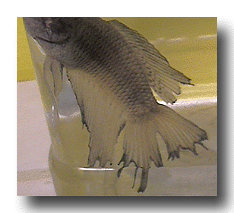
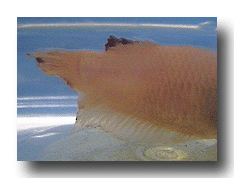
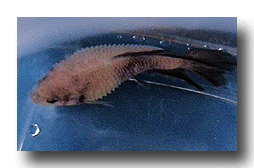
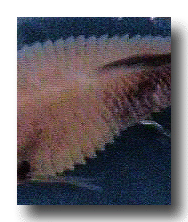
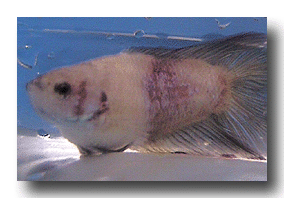 the red sores typical of
advanced bacterial infections
the red sores typical of
advanced bacterial infections